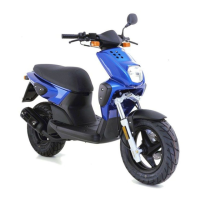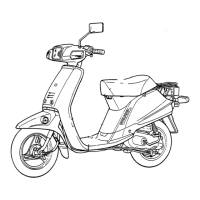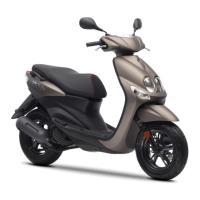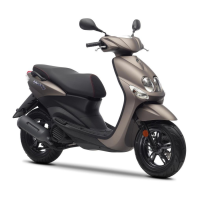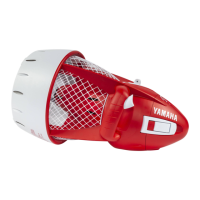Do you have a question about the Yamaha SLIDER EW50N and is the answer not in the manual?
Safety alert symbol for personal injury hazards.
Special precautions to avoid vehicle or property damage.
Key information to make procedures easier or clearer.
Owner's responsibilities for safe operation and proper maintenance.
Performing pre-operation checks and safe riding techniques.
Importance of helmet, goggles, jacket, trousers, gloves for safety.
Identifies components on the left side of the scooter.
Identifies components on the right side of the scooter.
Details the location and function of controls and instruments.
Operation of the main switch and steering lock functions.
Explains the function of various indicator and warning lights.
Details the speedometer, odometer, and fuel meter functions.
Describes controls on the left and right handlebars.
Explains dimmer, turn signal, horn, start switches, and brake levers.
Location and operation of fuel and oil tank caps.
Safe instructions for refueling the vehicle.
Details on the catalytic converter and exhaust system safety.
Checking and refilling 2-stroke engine oil.
How to use the starter (choke) lever for cold starts.
How to use kickstarter, seat, and anti-theft housing.
Load limits and usage of the luggage hook.
Checking fuel level and lines for leaks.
Checking engine oil level and for leaks.
Checking final transmission case for oil leakage.
Checking front brake operation, pads, fluid level, and system.
Checking rear brake operation, lever play, and system.
Checking throttle grip operation and free play.
Checking tire condition, tread depth, and air pressure.
Checking brake levers and centerstand operation and lubrication.
Checking fastener tightness and electrical system operation.
Detailed steps for starting the engine from cold.
Procedure for starting the engine when it is already warm.
Steps to safely move away from a stop.
How to adjust speed using the throttle.
Proper methods for applying brakes to avoid skids.
Advice on how to ride for better fuel efficiency.
Guidelines for the engine's critical initial period.
Safe practices for parking the scooter.
Why regular inspection, adjustment, and lubrication are crucial.
Schedule for emission system checks and services.
Schedule for routine maintenance and lubrication tasks.
How to check spark plug condition, gap, and tightening.
Procedure for checking and changing final transmission oil.
Steps to clean the air filter element properly.
Recommends dealer service for carburetor adjustments.
Importance of tire condition, replacement, and checking air pressure.
How to check tire tread depth and sidewall for damage.
Points for safe operation and maintenance of cast wheels.
How to check and adjust front brake lever free play.
How to check and adjust rear brake lever free play.
How to check front brake pads and rear brake shoes for wear.
Procedure for checking the brake fluid level.
When and how to change the brake fluid and hose.
Checking/lubricating control cables, throttle grip, and cable.
Lubricating the pivoting points of the front and rear brake levers.
How to check and lubricate the centerstand.
How to check the condition and operation of the front fork.
How to check for worn or loose steering bearings.
How to check front and rear wheel bearings for play or damage.
How to check electrolyte level and general battery care.
Steps to replace a blown fuse with the correct rating.
How to replace a burnt-out headlight bulb.
How to replace the tail/brake light bulb.
How to replace a burnt-out turn signal light bulb.
Guidance on diagnosing and resolving common vehicle problems.
A step-by-step chart for diagnosing issues with fuel, ignition, etc.
Advice on cleaning and protecting matte colored parts.
Importance of frequent and proper care for longevity.
Methods for cleaning the scooter safely and effectively.
Instructions for short-term and long-term storage.
Recording VIN and model label for parts and reference.
Safety alert symbol for personal injury hazards.
Special precautions to avoid vehicle or property damage.
Key information to make procedures easier or clearer.
Owner's responsibilities for safe operation and proper maintenance.
Performing pre-operation checks and safe riding techniques.
Importance of helmet, goggles, jacket, trousers, gloves for safety.
Identifies components on the left side of the scooter.
Identifies components on the right side of the scooter.
Details the location and function of controls and instruments.
Operation of the main switch and steering lock functions.
Explains the function of various indicator and warning lights.
Details the speedometer, odometer, and fuel meter functions.
Describes controls on the left and right handlebars.
Explains dimmer, turn signal, horn, start switches, and brake levers.
Location and operation of fuel and oil tank caps.
Safe instructions for refueling the vehicle.
Details on the catalytic converter and exhaust system safety.
Checking and refilling 2-stroke engine oil.
How to use the starter (choke) lever for cold starts.
How to use kickstarter, seat, and anti-theft housing.
Load limits and usage of the luggage hook.
Checking fuel level and lines for leaks.
Checking engine oil level and for leaks.
Checking final transmission case for oil leakage.
Checking front brake operation, pads, fluid level, and system.
Checking rear brake operation, lever play, and system.
Checking throttle grip operation and free play.
Checking tire condition, tread depth, and air pressure.
Checking brake levers and centerstand operation and lubrication.
Checking fastener tightness and electrical system operation.
Detailed steps for starting the engine from cold.
Procedure for starting the engine when it is already warm.
Steps to safely move away from a stop.
How to adjust speed using the throttle.
Proper methods for applying brakes to avoid skids.
Advice on how to ride for better fuel efficiency.
Guidelines for the engine's critical initial period.
Safe practices for parking the scooter.
Why regular inspection, adjustment, and lubrication are crucial.
Schedule for emission system checks and services.
Schedule for routine maintenance and lubrication tasks.
How to check spark plug condition, gap, and tightening.
Procedure for checking and changing final transmission oil.
Steps to clean the air filter element properly.
Recommends dealer service for carburetor adjustments.
Importance of tire condition, replacement, and checking air pressure.
How to check tire tread depth and sidewall for damage.
Points for safe operation and maintenance of cast wheels.
How to check and adjust front brake lever free play.
How to check and adjust rear brake lever free play.
How to check front brake pads and rear brake shoes for wear.
Procedure for checking the brake fluid level.
When and how to change the brake fluid and hose.
Checking/lubricating control cables, throttle grip, and cable.
Lubricating the pivoting points of the front and rear brake levers.
How to check and lubricate the centerstand.
How to check the condition and operation of the front fork.
How to check for worn or loose steering bearings.
How to check front and rear wheel bearings for play or damage.
How to check electrolyte level and general battery care.
Steps to replace a blown fuse with the correct rating.
How to replace a burnt-out headlight bulb.
How to replace the tail/brake light bulb.
How to replace a burnt-out turn signal light bulb.
Guidance on diagnosing and resolving common vehicle problems.
A step-by-step chart for diagnosing issues with fuel, ignition, etc.
Advice on cleaning and protecting matte colored parts.
Importance of frequent and proper care for longevity.
Methods for cleaning the scooter safely and effectively.
Instructions for short-term and long-term storage.
Recording VIN and model label for parts and reference.

